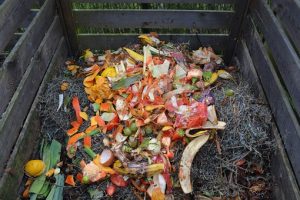Food. It’s what’s for dinner (and, well, breakfast and lunch). Until, that is, it becomes food waste. Did you know that more than 50 million tons of food waste goes to landfills every year, or that roughly half is generated at the household level (ReFED)? We can help reduce food waste through better meal planning, proper storage of produce, and preservation methods through canning or freezing. However, no matter how well we implement any of these strategies we will always have corncobs, carrot peels and ends, and other such waste that ultimately ends up discarded.
 What can we do? A compost pile is an option if you own your home and have a small space available in your yard. Backyard composting is common in United States, but is best suited for those who own a home with a yard. The renter and apartment dwellers without a yard face the greatest challenge. According to the National Multifamily Housing Council, 35% of residents (111 million people) in the United State rent the property they live in.
What can we do? A compost pile is an option if you own your home and have a small space available in your yard. Backyard composting is common in United States, but is best suited for those who own a home with a yard. The renter and apartment dwellers without a yard face the greatest challenge. According to the National Multifamily Housing Council, 35% of residents (111 million people) in the United State rent the property they live in.
The only city to truly address this challenge is San Francisco with its curbside composting program; one part of the city’s zero waste initiative. There, food waste is picked up by the city the same way they do for recycling and trash, but to be composted. In Cuyahoga County, we do not have curbside composting or a class II composting facility. As such, food waste has become a very salient issue in Cuyahoga County with many apartment dwellers looking for a compost option.
To address this challenge, OSU Extension and two local partners have teamed up. The Cuyahoga County Extension Office is hosting a Food Waste, Recovery, & Education project this summer at the Tremont Farmers’ Market. Farmers’ markets are great community spaces and provide the perfect location for educating residents on the full life cycle of food. In partnership with Rust Belt Riders, a local composting business, and StoneSoupCLE, a non-profit focused on food recovery, we are providing residents the opportunity to stop by the farmers’ market every Tuesday from June 20th through August 15th to drop off their food scraps for composting by Rust Belt Riders. When residents drop off their food scraps at the market, the scraps are weighed so we can track the pounds of waste diverted from landfills and provide residents with real data describing their individual impact and reduction in their carbon footprint.
What will you do to reduce your food waste? To learn more about food waste and food recovery systems, contact Amanda Osborne (osborne.414@osu.edu), County Extension Educator, Cuyahoga County & Western Reserve EERA.

 The economic effects of food waste are just as startling. Americans throw away the equivalent of $165 billion worth of food each year. In addition to food waste occurring at the consumer level, 10% of the total food supply at the retail level enters the solid waste stream. The USDA estimates that supermarkets lose $15 billion annually in unsold fruits and vegetables alone, in addition to the baked goods, meat, seafood, and ready-made foods that go unsold. These items can easily be recovered from the waste stream by donating them to local food banks and food pantries, and retailers can receive tax benefits for doing so.
The economic effects of food waste are just as startling. Americans throw away the equivalent of $165 billion worth of food each year. In addition to food waste occurring at the consumer level, 10% of the total food supply at the retail level enters the solid waste stream. The USDA estimates that supermarkets lose $15 billion annually in unsold fruits and vegetables alone, in addition to the baked goods, meat, seafood, and ready-made foods that go unsold. These items can easily be recovered from the waste stream by donating them to local food banks and food pantries, and retailers can receive tax benefits for doing so.